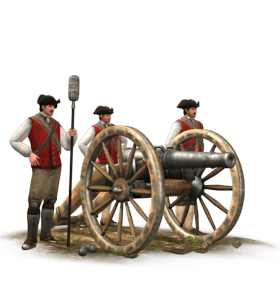Difference between revisions of "24-lber Foot Artillery (ETW Unit)"
Shackleton (talk | contribs) |
Shackleton (talk | contribs) |
||
| Line 1: | Line 1: | ||
| − | |||
{{TW Unit|image=[[Image:24_foot.jpg]] | {{TW Unit|image=[[Image:24_foot.jpg]] | ||
|Class=Artillery | |Class=Artillery | ||
Revision as of 16:08, 6 January 2013
 Foot artillery batteries are the core of an army on campaign: the weapons that win battles and batter down walls.
Foot artillery batteries are the core of an army on campaign: the weapons that win battles and batter down walls.
Overview
Despite the name, foot artillery batteries are towed by horses, not men. The artillerymen march alongside their pieces. All guns are smooth-bore, and rated by the size or weight of solid projectile that they fire: a 24-pounder is so called because it hurls a cannonball weighing 24 pounds towards the enemy! It may not do so very accurately, as the casting of barrels and balls means that there is inevitably a gap (wind-age) between a shot and the barrel sides. This means that a cannonball rattles down the barrel when fired, leading to an inherent inaccuracy. As technology advances, other types of ammunition can be fired.
Historically, there was limited standardization between guns, even in the same battery. Parts from one gun would not always fit a sister piece. A gunner would know the quirks of his own weapon intimately. Cunningly, the French attempted to develop a system of interchangeable components for all their guns and field equipment. Jean Baptiste Vaquette de Gribeauval (1715-1789), the inspector of artillery, tried but he wasn’t entirely successful. Even after he had finished there were still more than 20 different types of wheel in use!
Details
24-pounder foot artillery are the best cannon available to a generic army, although France, the Maratha Confedaracy, and the Ottoman Empire all have better options. They are able to use round shot, canister shot, and shrapnel. In addition, they can deploy some cover around them if they remain stationary on the world map for two turns or more, giving them substantial defense against missle fire; however, setting up such defensive measures robs them of their ability to redeploy and also shrinks their cone of fire by preventing them from turning. This can be a serious issue as enemy armies can simply reposition themselves and approach an entrenched position at a different angle in order to completely bypass any artillery fire.
Factions
 Great Britain
Great Britain United Provinces
United Provinces Afghanistan
Afghanistan Austria
Austria Bavaria
Bavaria Dagestan
Dagestan Gran Colombia
Gran Colombia Courland
Courland Denmark
Denmark France
France Genoa
Genoa Georgia
Georgia Greece
Greece Hannover
Hannover Hessen
Hessen Hungary
Hungary Ireland
Ireland Knights of St. John
Knights of St. John Louisiana
Louisiana Mamelukes
Mamelukes Maratha Confederacy
Maratha Confederacy Mexico
Mexico Mughal Empire
Mughal Empire Mysore
Mysore Naples & Sicily
Naples & Sicily New Spain
New Spain Norway
Norway Ottoman Empire (ETW Faction)
Ottoman Empire (ETW Faction) Italian States
Italian States Savoy
Savoy Poland-Lithuania
Poland-Lithuania Portugal
Portugal Prussia
Prussia Punjab
Punjab Quebec
Quebec Russia
Russia Persia
Persia Saxony
Saxony Scotland
Scotland Spain
Spain Sweden
Sweden Thirteen Colonies
Thirteen Colonies United States
United States Venice
Venice Westphalia
Westphalia Württemberg
Württemberg
